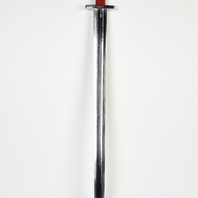
Viking Objects
Reproduction Viking Age Sword
A reproduction of the sword found in Grave 511 at Repton. The hilt is made of wood laths wrapped in tabby weave textile strips. The scabbard is made of two wooden laths, lined with trimmed sheep fleece, and covered in an oak-stained, stitched, calf-leather cover. The strap slide is copper alloy and inserted under the leather. The sword belt shown with the scabbard is based on the sword belt from Grave 511 at Repton.
Read More
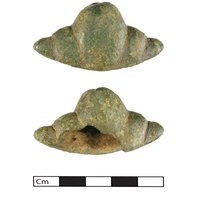
Viking Objects
Sword Pommel (NARC-E7AAF4)
An Anglo-Scandinavian copper-alloy sword pommel classed as a Petersen L type VI. The design is a fusion of Anglo-Scandinavian and Anglo-Saxon fashions. In many cases the design of the sword pommel is the only method of identifying the possible type and date of the sword it was attached to.
Read More
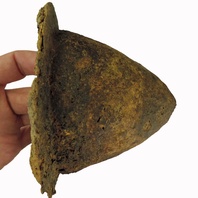
Viking Objects
Shield Boss (1989-59/9013)
This is a probable Viking shield boss from Repton, Derbyshire. This shield boss is possible evidence for the Viking Great Army’s overwintering at Repton in 873. The typical construction of a ‘Viking’ shield at the time involved several wooden planks glued together and cut into a circle. The face of the shield was then covered in linen or rawhide with rawhide edging that was either tacked or sewn on. Finally, a metal boss would be attached along with the handle over a hole in the centre. The purpose of the metal boss was to protect the user’s hand in combat.
Read More
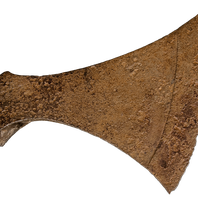
Viking Objects
Socketed Axe (LCNCC:1906.9661.2)
This large socketed iron axe head was found in the River Witham, east of Lincoln, Lincolnshire. Axes were not only a common implement used for a variety of wood-based activities, such as constructing ships, but also were often used as weapons. Axes came in a variety of shapes and sizes depending on their function. Considering the size and shape, this axe was most likely used for warfare rather than as a tool.
Read More
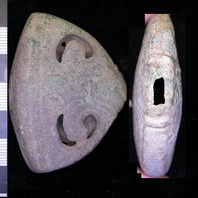
Viking Objects
Sword Pommel (LEIC-9158C3)
The pommel is probably a late development of Petersen’s type X which encompases transitional to medieval forms. Copper-alloy pommels with this basic shape are rare but not unknown in Viking Age Europe with a reasonably close example from Lough Derg, County Tipperary, in the National Museum of Ireland. The symmetrical Ringerike-style engraving is very similar to decoration commonly found on stirrup-strap mounts of the eleventh century.
Read More
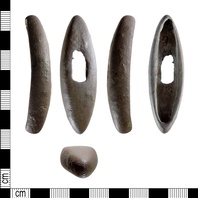
Viking Objects
Sword Hilt or Top Guard (DENO-87124F)
A copper-alloy hilt or top guard from an early medieval, possibly Viking, sword or dagger.
Read More
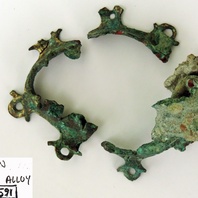
Viking Objects
Gilded Mount (1989-59/7591)
A gilded copper-alloy mount with approximately eight projecting pierced lugs. The mount was found in three pieces and is incomplete. It may originally have been domed, but most of the dome is missing. It has been suggested that it was a shield boss.
Read More
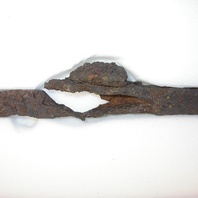
Viking Objects
Sword Fitting (1985/225-13)
This is the lower guard of a sword that may have been a Petersen Type H sword with triangular pommel. This style of sword is the most common type found in Norway and accounts for approximately 25% of those found in Ireland. It was found about 760mm from an iron sword blade in Mound 7, along with iron nails and a fragment of a possible iron spur.
Read More
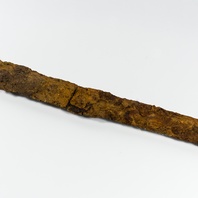
Viking Objects
Sword (1989-59/7113)
This Viking Age sword was found in Grave 511 at Repton where the invading Viking Great Army had their winter camp in 873/4. When it was found, the sword had traces of a wooden scabbard attached to the rusted blade. Analysis showed that the scabbard was lined with fleece and covered in leather. The grip was wooden and covered in a woollen textile.
Read More
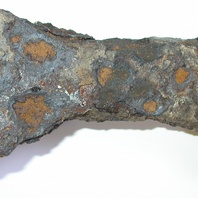
Viking Objects
Iron Axe-head (1989-58/3296)
Axes were not only a common implement used for a variety of wood based activities, such as constructing ships, but also were often used as weapons. Axes came in a variety of shapes and sizes depending on their function. This one was made to be a weapon and would have been wielded with a single hand. It was found at Repton in Derbyshire where there was a Viking camp which was recorded in the Anglo-Saxon Chronicle under the year 873/4.
Read More
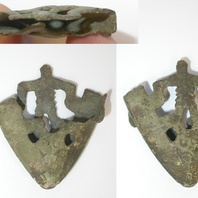
Viking Objects
Scabbard Chape (DENO-527092)
The decoration on this chape consists of a central human figure, with openwork apertures defining it, and a zoomorphic mask below.
